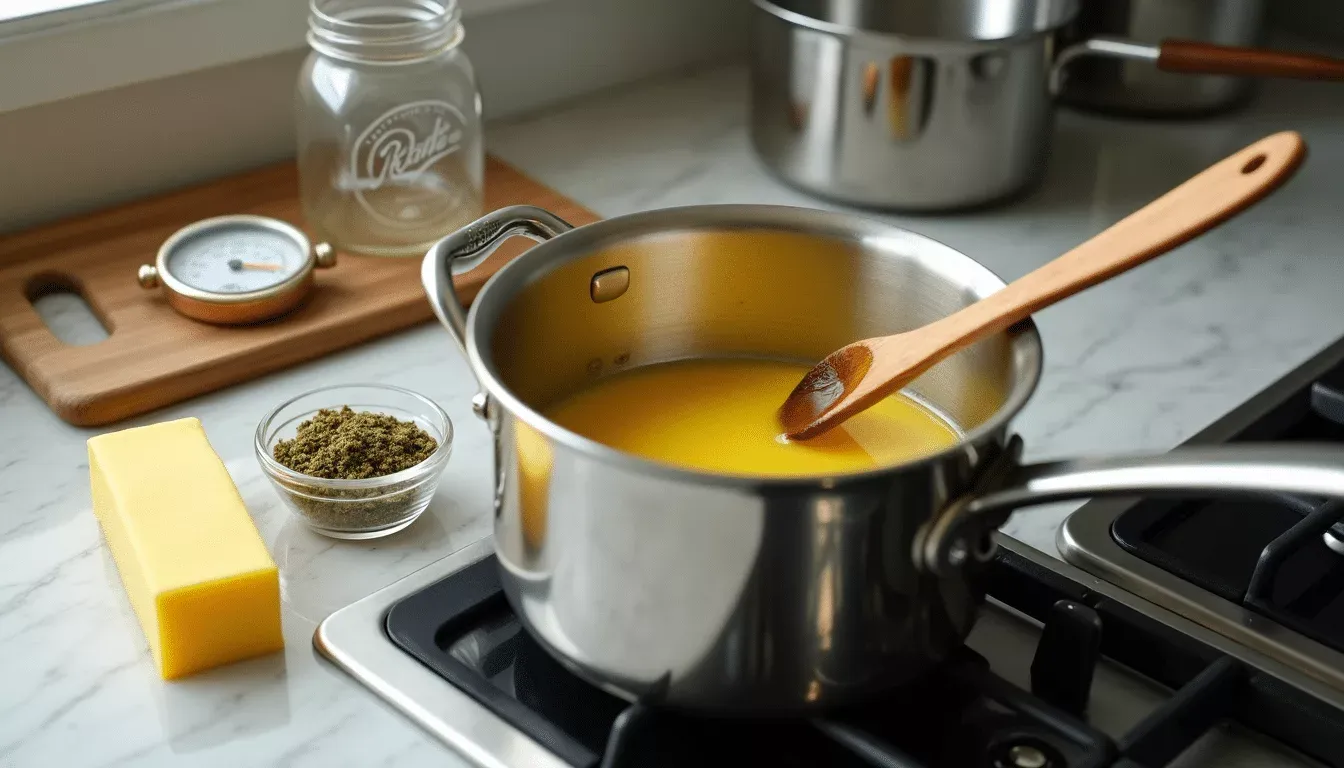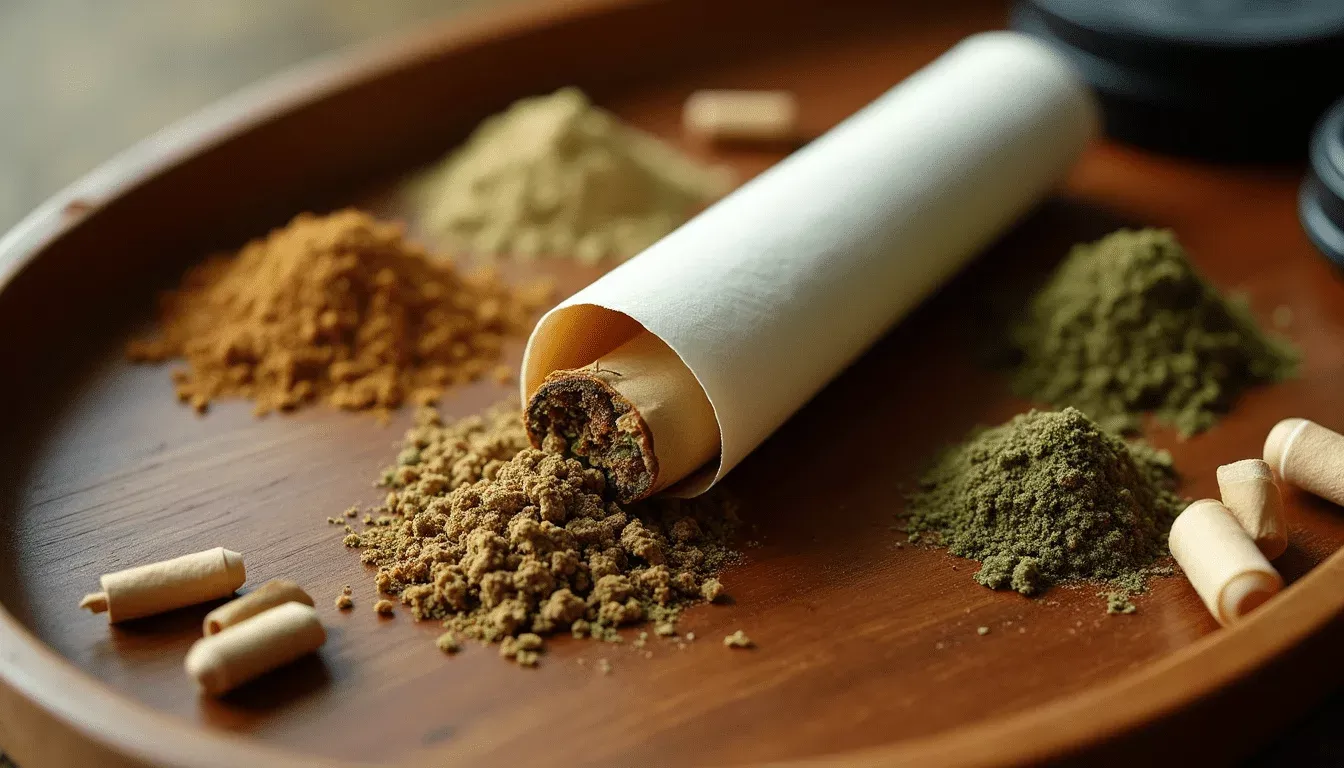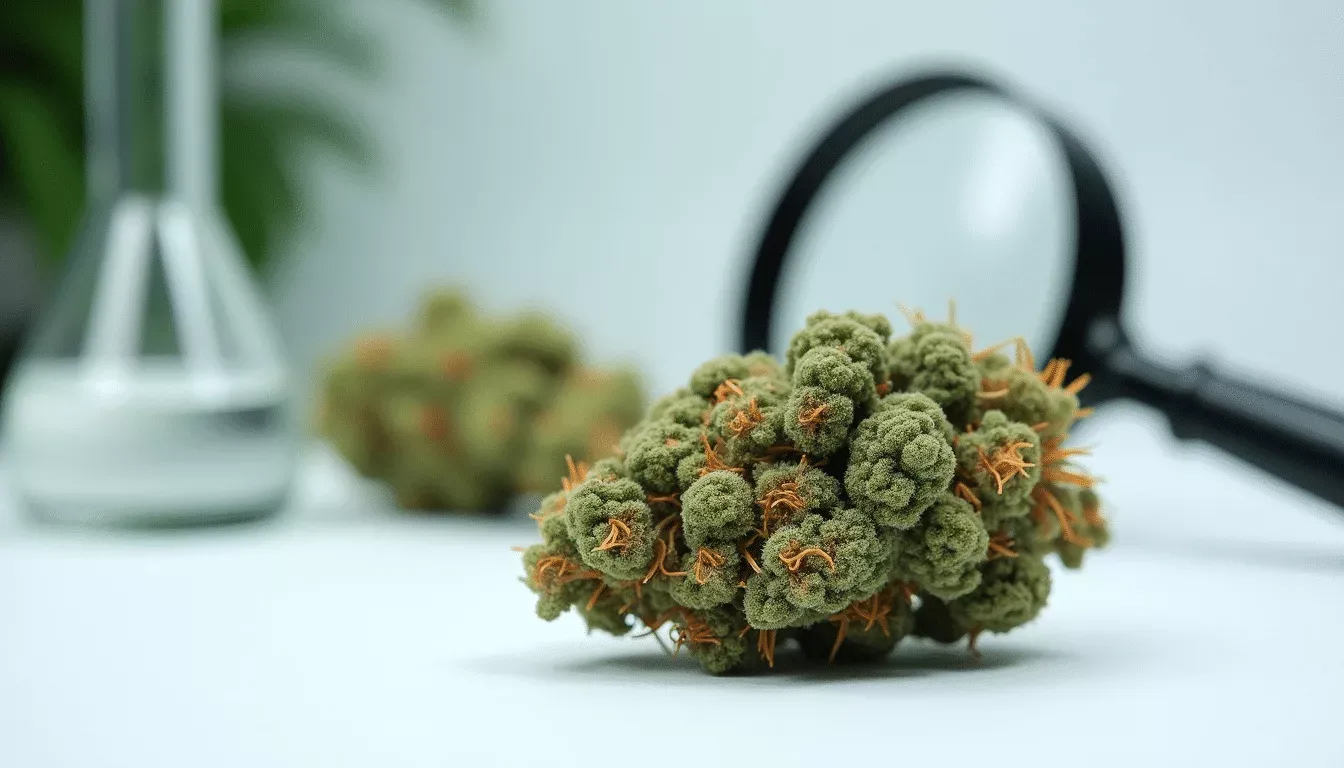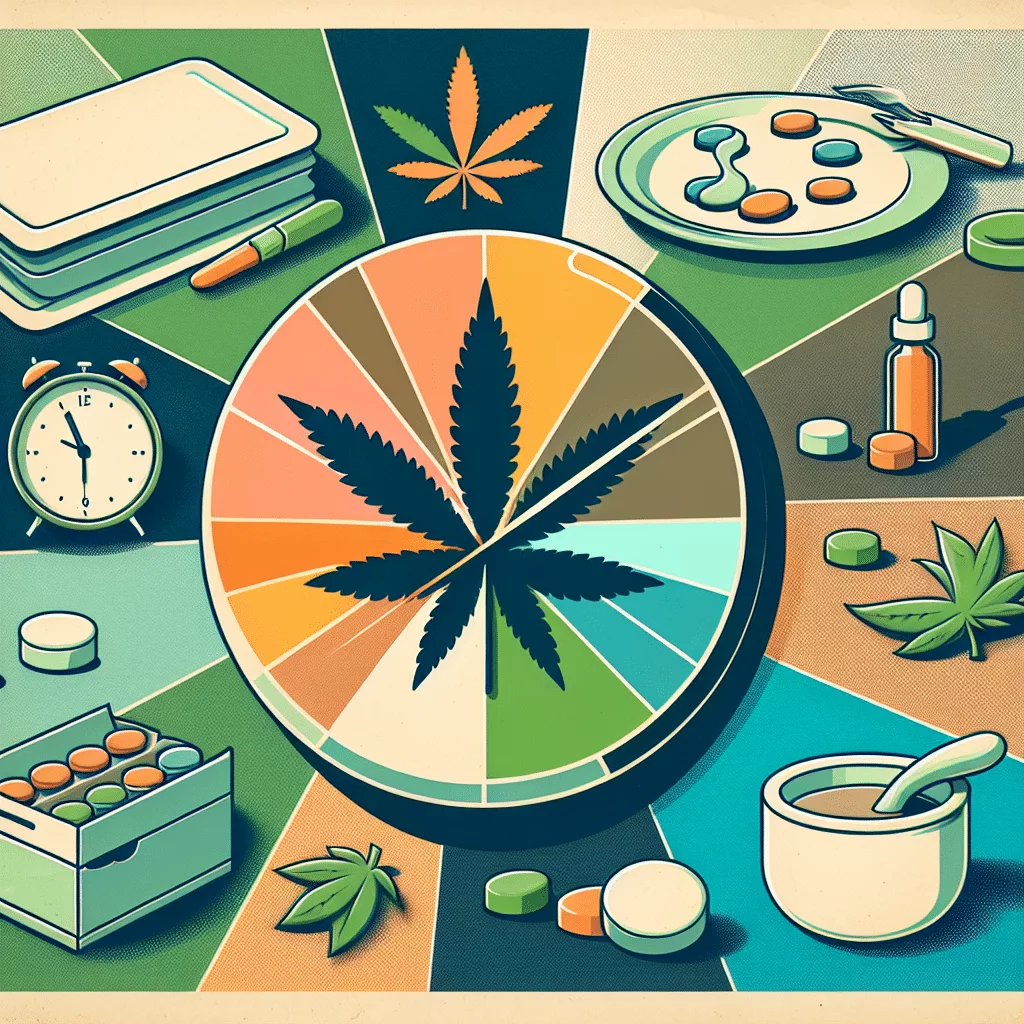How to Make Cannabutter: A Foolproof Recipe for Perfect Results
Cannabis edibles can keep you high for up to 8 hours. This duration is four times longer than what you experience with traditional smoking methods. For those interested in creating their own edibles, understanding how to make cannabutter is essential.
A tablespoon of cannabutter contains about 30mg of THC. Finding the right dose needs careful attention because edibles need 30 minutes to 2 hours before their effects begin. Users might consume extra portions quickly if they don’t wait long enough.
We created this detailed guide about cannabutter preparation to help you succeed. You’ll learn everything from the ideal cannabis-to-butter ratio (1 oz to 1 lb gives optimal results) to the vital decarboxylation process at 220°F. Each step will help you make perfect cannabutter that works for both recreational and medicinal purposes.
This foolproof recipe ensures consistent, quality results every time. You can use it to handle chronic pain, anxiety, or insomnia. The recipe also works great if you want to explore cannabis cooking. Let’s begin with the simple steps!
Choosing Your Cannabis for Cannabutter
“Know that using different strains can result in different experiences from each batch of cannabis infused-butter.” — Emily Kyle, Certified Cannabis Practitioner and Holistic Cannabis Practitioner
The secret to exceptional cannabutter lies in picking the right cannabis material. Your choice of cannabis will shape everything from potency and flavor to your finished edibles’ effects.
Buds vs. shake vs. trim: what’s the difference
You can use several forms of cannabis to make cannabutter. Each comes with its own characteristics and price points:
Buds (Flower): These dense, resinous parts of the cannabis plant pack the highest concentration of cannabinoids. Your best bet is to use whole cannabis flowers broken into large nuggets instead of finely ground material. Buds give you more potent cannabutter but cost more.
Shake: These small pieces fall off larger buds during handling and processing. Many people think shake is lower quality, but it’s just whole flower in smaller pieces. You’ll find shake at a discount in many dispensaries. This makes it a smart choice for cannabutter that doesn’t sacrifice much potency.
Trim: These are the parts trimmed away during processing—mostly sugar leaves and stems. Trim has lower levels of cannabinoids and terpenes than buds or shake. It works well for cannabutter since you’ll use more of it (about 1 oz of cannabis per 1 lb of butter).
How different strains shape your butter
Your strain choice changes your cannabutter’s effects and flavor by a lot:
THC vs. CBD Content: THC-rich strains pack more psychoactive punch, while CBD-heavy strains offer clearer-headed relief with less intoxication. Legal market strains usually contain around 25% THCA (which becomes THC), ranging from 10% to 35%.
Indica vs. Sativa: Indica strains create relaxing, body-centered effects in your cannabutter—perfect for evening use or pain relief. Sativa strains tend to give more energizing, cerebral effects that work better for daytime use.
Flavor Profiles: Each strain adds its own unique taste to your cannabutter:
- Citrusy terpenes work great with lemon-flavored baked goods
- Earthy, spicy strains match well with chocolate recipes
- Sweet, berry-flavored strains make fruit-based desserts better
Quality considerations for best results
The cannabis quality makes a big difference in your cannabutter:
Freshness: Unlike cooking with wine, poor quality or old cannabis won’t cut it. Chef Sheila Mitchell’s words ring true: “Quality matters… Cheap weed means pungent flavor but no power”.
Potency Testing: The THCA percentage helps you gage your cannabutter’s strength. You can find this info on dispensaries’ lab reports.
Decarboxylation Needs: Every form of cannabis needs proper decarboxylation before infusion. This vital process turns THCA into active THC through heat.
Butter Quality: Your butter’s quality plays a big role too. Premium butter creates better results. You can use salted or unsalted, though unsalted lets you control the final flavor better.
Your cannabis choice should match your desired effects, taste priorities, and budget. Beginners or those wanting milder effects should start with trim or lower-potency strains to ease into cannabis cooking.
Alternative Methods for Making Pot Butter
Traditional stovetop methods aren’t the only way to make potent cannabutter. Cannabis enthusiasts have found better ways that give you more control over temperature, create less mess, and deliver consistent results. Let me show you three methods that will change how you make edibles.
How to make cannabutter in a crockpot
The slow cooker method has become a favorite because you can leave it alone and won’t risk burning your butter. A crockpot keeps temperatures steady and low, which pulls out cannabinoids perfectly without burning them off.
Start by putting a dish towel at the bottom of your crockpot to give your mason jar a stable base. Fill the pot halfway with hot water and put an empty mason jar inside until it’s half-submerged. This water bath helps you handle things safely and spreads heat evenly.
You’ll get the best results if you decarboxylate your cannabis first. Break up 7 grams of flower per stick of butter (don’t use grinders since they add too much plant matter) and bake it in a sealed mason jar at 240°F for 90 minutes. Add one stick of butter to the jar, seal it tight, and put it in your water bath.
Set your crockpot to its lowest setting and keep the temperature between 160-200°F. The infusion takes:
- 2-3 hours for mild potency
- 4-8 hours for medium strength
- 8-24 hours for maximum potency
Chef Mitchell loves this method because “It’s the easiest way to not burn anything, and I don’t have to worry about personally controlling the heat”.
Sous vide cannabutter technique
Sous vide, which means “under vacuum” in French, gives you amazing precision when making cannabutter. You vacuum-seal your ingredients and put them in temperature-controlled water.
Sous vide cannabutter gives you perfect temperature control, keeps your house from smelling like cannabis, and runs by itself. Cannabis chef Lo says it best: “Since the cannabis and oil or butter are sealed and placed under water to infuse, there’s no smell. There’s also no need to babysit a stovetop or an open flame”.
The process starts with decarboxylating your ground cannabis in a vacuum-sealed bag at 200°F for 4-6 hours. Add 8 oz of butter to a new bag with the decarboxylated cannabis and sous vide for another 4-6 hours at 185°F. Strain the mixture through cheesecloth at the end and press to get every drop of infused butter.
Using a dedicated infusion machine
Special cannabis infusers have changed the game for making cannabutter at home. These smart devices handle everything from decarboxylation to infusion and straining.
The Magical Butter Machine (MB2e) comes with four pre-programmed settings: a one-hour oil button, a two-hour butter button, a four-hour tincture button, and an eight-hour setting for longer infusions. This versatility makes it great for all kinds of cannabis recipes beyond butter.
LEVO stands out as another popular choice with its precise temperature controls that extract maximum potency. LEVO’s website highlights that it “automatically filters hot oil—no accessories needed” and lets you “dry, decarb, infuse, & dispense at the touch of a button”.
These machines offer some great features:
- They clean themselves
- They keep smells contained
- They give you the same results every time
- You can program them for different strains
These special devices cost more upfront than manual methods, but many enthusiasts think they’re worth it for their consistency and convenience.
Creating Cannabutter with Different Materials
Your choice of material—shake, trim, or concentrates—will affect your cannabutter’s potency, flavor, and cost. Each type needs specific techniques to get the best results.
How to make pot butter with shake
Shake gives you an affordable option compared to premium buds without losing much potency. These small pieces fall off larger buds during handling and pack almost the same cannabinoid content as whole flower.
Making cannabutter with shake is easy. Start by decarboxylating your shake at 240°F for 40 minutes. Mix using a 1:1 ratio in cups—one cup of shake to one cup of melted butter. You can bump this up to 1¼ cups shake per cup of butter if you want it stronger.
Shake’s biggest advantage is its price point. Dispensaries often sell it at big discounts, which makes it perfect if you’re making large batches of edibles. The pieces are already broken down, so you won’t need to grind them further.
Using trim for economical cannabutter
Trim comes from sugar leaves and fan leaves removed during harvest. It has lower cannabinoid levels but costs way less than buds or shake. Sugar leaves pack about 5-7% cannabinoids, and larger fan leaves contain just 2-3%.
You’ll need to adjust your measurements with trim. A good rule is to double what you’d use for flower—2 ounces of trim for every 2 cups of butter. This makes up for trim’s lower potency and ensures good coverage of the plant material.
Home growers love using trim that would usually go to waste. Turning these leftover leaves into cannabutter makes it an incredibly affordable choice.
Making cannabutter with wax or concentrates
Cannabis concentrates like wax, shatter, or distillate create super-potent cannabutter with minimal plant material. Your edibles will taste cleaner without that strong herbal flavor you get from flower-based infusions.
Wax-based cannabutter is quick and simple to make. Most concentrates (except THCA crystals) are already decarboxylated, so you can skip that step. You can add distillate and RSO (Rick Simpson Oil) straight into melted butter.
Set up a double boiler and melt your butter over low heat (160-200°F) to start the infusion. Add your concentrate and stir until it dissolves completely—this usually takes 2-3 hours.
Concentrates let you measure doses more accurately. Using concentrate with known THC percentages helps you calculate exact potency in your final product, so you can control serving strengths better.
Perfecting Your Cannabutter Ratio
The right cannabis-to-butter ratio makes all the difference when you want to create consistent, properly dosed edibles that work for you. This balance affects both how strong your edibles will be and how they’ll taste, which makes it a vital part of making good abutter.
Standard cannabis to butter ratios
Most cannabis experts say you should use a 1:1 ratio in cups—one cup of cannabis to one cup of butter. If you’re weighing ingredients, you’ll need one pound of unsalted butter for every seven grams of decarboxylated, coarsely ground cannabis. These measurements are a good place to start for most home cooks.
Some recipes suggest using one ounce (28 grams) of cannabis with one pound of butter if you want something really potent. New cooks should start with less cannabis and work their way up as they get more comfortable.
Adjusting potency for different needs
You can adjust the strength of your butter with some basic math. If your butter turns out too strong, here’s what you can do:
- Mix cannabutter with regular butter at a 50/50 ratio
- Use less cannabis (try ½ cup of ground flower to 1 cup butter)
- Add more butter (same cannabis with more butter makes it less potent)
If you want stronger effects, bump up the cannabis-to-butter ratio to 1¼ cups ground flower per cup of butter. Note that once you’ve made your cannabutter, you can’t make it stronger—you’ll just need to use more in your recipes.
Balancing flavor and strength
Cannabis can sometimes take over the taste of your dishes. Here’s how to get better flavor while keeping the effects you want:
- Test a small amount first (start with ¼ teaspoon and wait an hour to see how it hits)
- Find your sweet spot through careful testing (10mg THC is standard in legal markets)
- Use high-quality butter because better ingredients make everything taste better
The type of cannabis you use changes these ratios too. Kief-based cannabutter can be four times stronger than butter made with trim. People who need higher doses for medical reasons might want to use concentrates or kief to get more potency without overwhelming flavor.
Regular users typically take 10-15mg THC doses in commercial edibles, while experienced users might go for 15-30mg. If you’re new to this, start with just 5mg and build up from there.
Using Your Cannabutter in Recipes
“Ready to bake your favorite weed brownies and cookies? Have no fear; it is OK to bake your homemade cannabutter at higher temperatures.” — Emily Kyle, Certified Cannabis Practitioner and Holistic Cannabis Practitioner
A perfect batch of cannabutter opens up countless culinary possibilities. You can replace standard butter with cannabutter in almost any recipe to create sweet and savory cannabis-infused dishes.
Sweet applications for cannabutter
Desserts make an excellent canvas for cannabutter because they mask the herb’s distinctive flavor. Brownies and cookies stand as classic choices, and cannabis chocolate chip cookies give you the perfect balance of crispy edges and chewy centers. Cannabis buttermints, fudge, or cheesecake work great as no-bake options and help preserve cannabinoids since they don’t need heating.
Your dessert options go beyond these simple choices. Cannabis-infused apple pie lets the butter’s herbal notes blend with the spiced filling. A cannabis buttercream frosting needs just four ingredients to turn ordinary cakes into special treats.
Cannabis-infused hot chocolate and golden milk serve as comforting options, especially in cold weather.
Savory dishes that work well with cannabutter
Savory dishes showcase cannabutter’s herbal profile better than sweets. Pasta dishes really shine with cannabutter—you can add it to creamy fettuccine alfredo or create a rich cannabutter sauce with clams and capers.
Melted cannabutter drizzled over asparagus or mixed into mashed potatoes makes great side dishes. Creamy soups like split pea with thyme and miso carry the flavor exceptionally well.
Breakfast options include cannabutter spread on toast or mixed into pancake batter. Roasted garlic cannabutter bruschetta canapés or spinach artichoke dip make excellent appetizers.
Tips for even distribution in recipes
Even distribution gives you consistent dosing throughout your creations. Mix cannabutter really well into your recipe ingredients because uneven mixing results in inconsistent effects. Keep baking temperatures below 340°F since THC starts breaking down above this point.
You can calculate total THC content and divide by serving count for precise dosing. Start small—replace only part of the regular butter until you understand the potency. Note that edibles take 30-60 minutes to show effects, sometimes up to 2 hours, so wait patiently before eating more.
Different strength batches—a standard and a milder version—let you choose the right potency for various recipes and occasions.
Conclusion
The perfect cannabutter needs close attention to detail. You must select the right cannabis material and keep precise temperatures during infusion. Premium flower, economical trim, and concentrates each give you unique benefits to create potent, flavorful infusions. Modern methods like sous vide and dedicated infusion machines have made the process more available and consistent.
Cannabutter’s uses go way beyond the reach and influence of traditional pot brownies. Sweet and savory dishes taste great with cannabis-infused butter. Proper dosing is a vital part of creating enjoyable experiences. Start with small amounts and track the effects to understand your personal tolerance levels better.
Your patience and precision will lead to great cannabutter. Measure your ingredients well, decarboxylate properly, and mix thoroughly to ensure your finished product has consistent potency. Note that edibles need 1-2 hours to show their effects compared to other consumption methods. Wait this time before having more to avoid discomfort and enjoy your culinary cannabis creations fully.
Share this content:



